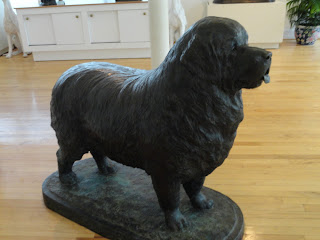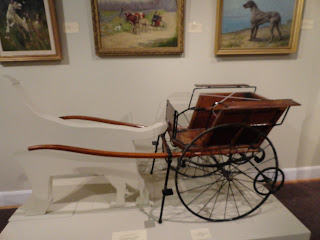Who knew there even was an AKC dog museum? It exists on South Mason Road in St Louis in Queeny Park. According to the brochure, it "boasts the country's largest collection of art, artifacts, and literature on man's best friend". Among the special exhibits are: "Sled Dogs: Exploration and Endurance"; St Louis canine corps; "The Art Show at The Dog Show" - past winners of the art show at the Wichita Kennel Club show held since 1987; a unique collection of matchbook covers featuring dogs; as well as paintings, sculptures and artifacts of dogs from 16th century to present.
Since this was my first day off in St Louis, and needed to also get Jane out of the room for the cleaning service, we decided this was a perfect time to visit the museum. It resides in Queeny Park (the original house (which is part of the museum) and grounds were donated by the people who founded the Monsanto Corporation). It made me wonder what they would think of the corporation today. To me, the name Monsanto brings up images of the "evil corporate giant"; suing small farmers over genetic corn and wheat rights (when it was their genetically modified pollen that floated into the small farmers field); providing mountains of processed food to the public, etc. The original owners were apparently more philanthropically minded as they donated a lot to charity in the Saint Louis area.
Jane was well received at the museum. She didn't care for the grey, drippy day outside and was glad to go back indoors. Well mannered, housebroken dogs are allowed into the museum. Since she is only 11 weeks old, they graciously allowed Jane to come in as well after I assured them I intended to carry her around anyway. She is certainly neither house broken nor good on a leash! Yet! They thought she was cute and adorable and the museum staff cooed over her. The lady in the gift store even held her for me while I browsed. Jane's favorite part of the museum was the statues and sculptures. Those were the only thing she really perked up for and stared at hard. Mostly she was content to sigh and snooze in my arms.
One of the most interesting exhibits was "Dog Collars From Sterling Silver to Iron Spikes". It was amazing to see some of the huge heavy collars. I told Jane she should be glad we'd progressed to the light nylon stuff she is wearing! Some were beautiful and decorative while a few others were little more than links of metal spikes worn by guard dogs or hunting dogs. I will borrow here from an article that the museum hands out to everyone:
Throughout the centuries dog collars have been reflections of both society and history, serving as symbols of status and as a means of restraint, protection or identification. Although collars today very from the simple to the decorative, early collars were designed for the specific purpose of protection. Archaeological evidence indicates that early man devised wide circles of metal, sometimes lined with leather, to shield both his own vulnerable throat and that of his canine companion from the attacks of predators. Representations of dogs wearing collars in Middle Eastern and Egyptian art, in fact, show the broad leather bands usually associated with hunting dogs.
In contrast to collars constructed for protection, some early surviving collars are the beaded and tasselled necklets found on the mummified remains of ancient Egyptian lapdogs. Later the Greeks and Romans lavished gold and coral collars on their household pets, while guard dogs wore sturdy iron bands with sharp spikes. The Pekingese and Shih Tzu, considered sacred in the palaces of China, wore lavish collars from which hung tassels identifying the dog's status in royal court.
In Europe, from the Middle Ages on into the 19th century, collars made of precious metals and studded with jewels adorned the pampered pets of kings and the wealthy, while simpler ones identified the prized possessions of commoner folk. It was not unusual to find the name of an owner engraved on a collar to ensure the identification of their property, similar in purpose to our modern day practice of using identification tags. Spiked collars continued to protect hunting and guard dogs from enemies -- both animal and human.
Because of their beauty and value -- and perhaps because they were lasting reminders of beloved pets -- dog collars have been saved and collected throughout the centuries. Most of the collars belonging to The Dog Museum date from the 19th and 20th centuries and were made by unknown artists and craftsmen. They vary from an elegant sterling silver collar with a padlock once belonging to the Duke of Lancaster's mastiff to a plain copper band closed with a leather buckle. Many examples of spiked collars are also on show.
The AKC Dog Museum is a neat little place - well worth the $5 admission fee. If you're ever in St Louis, make an effort to visit. Jane and I will probably head back on a sunny day to explore some of the trails in Queeny park. At the moment, she's exhausted from a morning of museum touring and is snoozing away!
Since this was my first day off in St Louis, and needed to also get Jane out of the room for the cleaning service, we decided this was a perfect time to visit the museum. It resides in Queeny Park (the original house (which is part of the museum) and grounds were donated by the people who founded the Monsanto Corporation). It made me wonder what they would think of the corporation today. To me, the name Monsanto brings up images of the "evil corporate giant"; suing small farmers over genetic corn and wheat rights (when it was their genetically modified pollen that floated into the small farmers field); providing mountains of processed food to the public, etc. The original owners were apparently more philanthropically minded as they donated a lot to charity in the Saint Louis area.
Jane was well received at the museum. She didn't care for the grey, drippy day outside and was glad to go back indoors. Well mannered, housebroken dogs are allowed into the museum. Since she is only 11 weeks old, they graciously allowed Jane to come in as well after I assured them I intended to carry her around anyway. She is certainly neither house broken nor good on a leash! Yet! They thought she was cute and adorable and the museum staff cooed over her. The lady in the gift store even held her for me while I browsed. Jane's favorite part of the museum was the statues and sculptures. Those were the only thing she really perked up for and stared at hard. Mostly she was content to sigh and snooze in my arms.
One of the most interesting exhibits was "Dog Collars From Sterling Silver to Iron Spikes". It was amazing to see some of the huge heavy collars. I told Jane she should be glad we'd progressed to the light nylon stuff she is wearing! Some were beautiful and decorative while a few others were little more than links of metal spikes worn by guard dogs or hunting dogs. I will borrow here from an article that the museum hands out to everyone:
Throughout the centuries dog collars have been reflections of both society and history, serving as symbols of status and as a means of restraint, protection or identification. Although collars today very from the simple to the decorative, early collars were designed for the specific purpose of protection. Archaeological evidence indicates that early man devised wide circles of metal, sometimes lined with leather, to shield both his own vulnerable throat and that of his canine companion from the attacks of predators. Representations of dogs wearing collars in Middle Eastern and Egyptian art, in fact, show the broad leather bands usually associated with hunting dogs.
In contrast to collars constructed for protection, some early surviving collars are the beaded and tasselled necklets found on the mummified remains of ancient Egyptian lapdogs. Later the Greeks and Romans lavished gold and coral collars on their household pets, while guard dogs wore sturdy iron bands with sharp spikes. The Pekingese and Shih Tzu, considered sacred in the palaces of China, wore lavish collars from which hung tassels identifying the dog's status in royal court.
In Europe, from the Middle Ages on into the 19th century, collars made of precious metals and studded with jewels adorned the pampered pets of kings and the wealthy, while simpler ones identified the prized possessions of commoner folk. It was not unusual to find the name of an owner engraved on a collar to ensure the identification of their property, similar in purpose to our modern day practice of using identification tags. Spiked collars continued to protect hunting and guard dogs from enemies -- both animal and human.
Because of their beauty and value -- and perhaps because they were lasting reminders of beloved pets -- dog collars have been saved and collected throughout the centuries. Most of the collars belonging to The Dog Museum date from the 19th and 20th centuries and were made by unknown artists and craftsmen. They vary from an elegant sterling silver collar with a padlock once belonging to the Duke of Lancaster's mastiff to a plain copper band closed with a leather buckle. Many examples of spiked collars are also on show.
The AKC Dog Museum is a neat little place - well worth the $5 admission fee. If you're ever in St Louis, make an effort to visit. Jane and I will probably head back on a sunny day to explore some of the trails in Queeny park. At the moment, she's exhausted from a morning of museum touring and is snoozing away!













So cool! Thanks for throwing a Brittany pic in there! :)
ReplyDelete